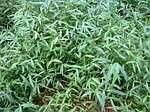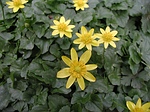Invasive Plants in Palisades
There are several unpleasant plants that seem to be increasing around Palisades; Japanese stiltgrass, which I've mentioned before, has become so ubiquitous - and entrenched - that I hesitate to even include it as one worth battling. It resembles small, delicate bamboo and, when mature, grows two to three feet in height and takes over lawns with its twig-like stems, choking out the desired grass.
You can try poisoning it, but in addition to being environmentally iffy, it's not terribly effective. The thing is,
stiltgrass is very easy to mow down or pull up before it
goes to seed in the fall. But it's an annual whose seeds
can remain active in soil for as long as seven years, so
having it hacked down after it's already started to seed,
as I've observed many landscapers do, is not only a
waste of effort, it actually promotes the spread and
germination of the new seed. The plant spreads not only
by seeding but also by rooting at joints along the stem -
a new plant can emerge from each node; a single plant
can produce anywhere from 100 to 1,000 seeds. Hand
pulling in late summer, ideally before seeds set, can be
effective; its shallow roots are generally easy to pull.
Another deceptively-attractive newcomer, at least to my yard, is Ranunculus ficaria, or fig buttercup, a plant with dark shiny green leaves and early yellow flowers. To quote The Invasive Plant Atlas of New England, "Ranunculus ficaria poses a great threat to early blooming spring plants…it outcompetes them for re- sources and forms dense mats that exclude most other spring vegetation." It also reproduces both via seeds, and by tuberous spreading roots that are difficult to pull, and choke nearby plants. Mine moved in years ago with something transplanted from Margaret Anderson; it didn't multiply much at first, but global warming seems to agree with the fig buttercup. Large areas of my lawn are covered with it this spring. If you see this plant starting anywhere in your yard, dig it up, being careful not to spread the numerous friable tubers, before it takes over! The third type of invasive plant I want to touch on is the edible kind in hopes that by fostering some culinary interest their prevalence can be diminished (if you can't beat 'em, eat 'em!). There's garlic mustard, whose leaves, according to Wikipedia, "are used for flavoring in salads and sauces such as pesto…best when young, and provide a mild flavour of both garlic and mustard."
Plantain and dandelion, too, are easy to find all around us, and have value as both food and medicine. Again from Wikipedia: "Plantago major is one of the most abundant and widely distributed medicinal crops in the world. A poultice of the leaves can be applied to wounds, stings, and sores in order to facilitate healing and prevent infection…plantain has astringent proper- ties, and a tea made from the leaves can be ingested to treat diarrhea and soothe raw internal membranes. Broadleaf plantain is also a highly nutritious wild edible that is high in calcium and vitamins A, C, and K. The young, tender leaves can be eaten raw, and the older, stringier leaves can be boiled in stews and eaten."
In addition to these familiar “resident aliens” there's (hairy) bitter cress, a relatively new visitor that seems to be making itself very comfortable here. Several sites, including Wikipedia, call it edible as a 'bitter herb', but I haven't yet found a preparation I'd call tasty. Which is unfortunate, because with its exploding seeds (possibly thousands for a large plant) and long sea- son (plants may be in fruit for 8 months of the year), there's a lot of it to be eaten!
However you choose to deal with invasives in your yard, please be mindful that many herbicides are dangerous to frogs and other wildlife, that the runoff or over- spray can hurt other plants, and that they may not be as safe for the environment, or as effective in the long run, as a little well-timed elbow grease (otherwise known as pulling weeds before they seed). For more information:www.eddmaps.org



